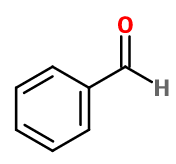
Photo credits: ScenTree SAS
Benzaldehyde
Benzoic Aldehyde ; Almond artificial oil ; Benzanoaldehyde ; Benzarone ; Benzene carbaldehyde ; Benzene carbonal ; Benzene carboxaldehyde ; Benzene methylal ; Benzene carbinal ; Benzenecarbonal ; Benzenemehylal ; Benzoyl hydride ; Phenyl methanal ; Phenylformaldehyde ; Phenylketone ; Phenylmethanal

Photo credits: ScenTree SAS
| Company | Ingredient Name | ID | Naturality | Purity | Latin name | Treated part | Geographical origin | Certifications | Comments | MOQ |
|---|---|---|---|---|---|---|---|---|---|---|
|
|
Benzaldéhyde - 30gr | - | - | - | - | - | - | more | - |
General Presentation
-
CAS N° : 100-52-7
-
EINECS number : 202-860-4
-
FEMA number : 2127
-
Density : 1,045
-
Optical rotation : Donnée indisponible
-
Allergens : This ingredient does not contain any allergen.
-
Refractive Index @20°C : Donnée indisponible
-
Volatility : Head
-
Price Range : €
-
Appearance : Colorless viscous liquid
-
FLAVIS number : 05.013
-
JECFA number : 22
Information on synthetic ingredients
-
Acid Value : Donnée indisponible
-
Boiling Point : 179°C
-
Detection Threshold : Varie selon les personnes entre 100 ppb et 4,6 ppm (0,00046%), lorsque son seuil de reconnaissance varie entre 330 ppb et 4,1 ppm
-
Molecular formula : C7H6O
-
Log P : 1,5
-
Molecular Weight : 106,12 g/mol
-
Fusion Point : -26°C
-
Flash Point : 64°C
-
Vapor pressure : Donnée indisponible
Uses
Other comments :
As it can be compared to Furfural and Salicylaldehyde, Benzaldehyde is the reference almond note in perfumery.
Stability :
Tends to oxydize easily into perbenzoic acid, which can react with itself to onvert it into Benzoic Acid.
Tends to color through time.
Uses in perfumery :
Benzaldehyde is used in almond, fruit stone and nutty notes. Gives nuances to vanilla notes.
Year of discovery :
Discovered in 1863.
Isomerism :
Benzaldehyde does not have any isomer used in perfumery.
Synthesis precursor :
Benzaldehyde is the precursor to the synthesis of many compounds used in perfumery. For example, its hydrogenation synthesizes benzoic alcohol. It condenses with other aldehydes to create many other compounds, replacing the aldehyde function with an alcene function. Finally, a Perkin reaction with several acids allows to obtain various compounds, such as Cinnamic Acid by reaction with acetic anhydride. Finally, benzaldehyde forms a Schiff base by reaction with Methyl Anthranilate or Indole for example.
Natural availability :
Benzaldehyde can be found in almond, several fruits, Vanilla Bourbon Absolute (and other origins), Grandiflorum Jasmine Absolute and fruit stones. In its natural state, it is extracted from Bitter Almond EO, of which it is the major compound.
Synthesis route :
Benzaldehyde is synthesized by hydrolysis of benzyl chloride, by an acidic route in the presence of iron chloride, or by an alkaline route in the presence of sodium carbonate. A toluene oxidation also allows to obtain both Benzoic Acid and Benzaldehyde.
Regulations & IFRA
-
IFRA 51th : This ingredient is restricted by IFRA
-
Restriction type : RESTRICTION
-
Cause of restriction : DERMAL SENSITIZATION AND SYSTEMIC TOXICITY
-
Amendment : 49
- Quantitative limit on the use :
-
Cat.1 Cat.2 Cat.3 Cat.4 Cat.5A B C DCat.6 0,045 % 0,014 % 0,27 % 0,25 % 0,064 % 0,064 % 0,064 % 0,021 %0,15 % Cat.5A B C DCat.6 0,064 % 0,064 % 0,064 % 0,021 %0,15 % Cat.7A BCat.8 Cat.9 Cat.10A BCat.11A BCat.12 0,52 % 0,52 %0,021 % 0,49 % 0,49 % 1,8 %0,021 % 0,021 %No Restriction Cat.10A BCat.11A BCat.12 0,49 % 1,8 %0,021 % 0,021 %No Restriction
Comments :
This ingredient is part of the Schiff base (Benzaldehyde methyl anthranilate (or Amandolene) - N°CAS : 39129-16-3) and induces the application of IFRA regulations for 44,4% of the Schiff base usage. Please also refer to the IFRA Annex II for more information

